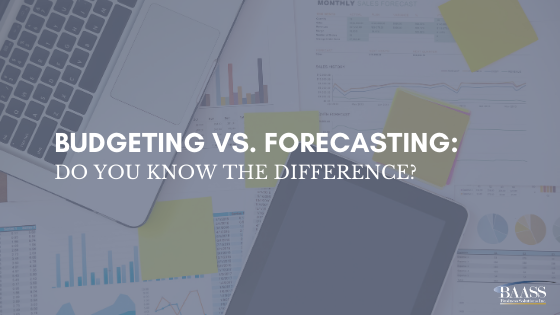
To some capacity, your organization has likely prepared a budget or forecast before. These two functions help businesses in terms of strategies, decisions, and many other business processes. Budgeting and forecasting are salient aspects of an organization that need to be considered.
While the two seem similar, they are diverging tools with their own respective uses. Although often used in tandem, one should not be a substitute for the other. In this blog post, we share the primary differences between 2 financial tools: budgeting and forecasting.
Budgeting
At a high level, a budget quantifies an organization’s plans for a particular period in terms of revenues and expenses. This is often expressed through any expected cash inflows or outflows. For instance, a budget may factor in facets such as monthly expenses, expected liabilities, estimated net income, credit cards, living expenses, fixed and/or variable costs, etc.
Budgets are useful in acting as a guide for organizations when it comes to tracking your spending. Ideally, the more detailed and personalized a budget is, the more it can keep your organization on track and save money. At the end of the period, comparing the budget to actual expenses and revenues helps managers to evaluate their performance. Essentially, the budget acts as a baseline to compare variances in spending, earnings, and other factors.
While it can be considered a source of control or a guide for organizations, it can also represent a business’ goals for the year. As mentioned, it’s a facet that can support strategic planning in terms of making decisions, allocating resources, and prioritizing objectives. Compared to forecasting, budgets are generally more short-term. They are made in preparation for at most, one accounting period.
It is important to note that budgets, which are generally static, can be rendered nearly useless if market conditions have significantly changed. Organizations should be evaluating if the targets outlined in their budgets are still attainable in the context of the current market state. This can be important to keep in mind when creating a budget.
Forecasting
Forecasting utilizes historical data to estimate and project future outcomes in terms of revenues and expenses for a business. It can be used as a baseline to support and quantify budgets. Despite where an organization is headed in terms of its financials, a forecasting tool can be used for both the short and long term.
Furthermore, management can leverage a combination of their business’ forecasts, historical data and market research to identify trends in the company. Companies can expect to better manage their cash if they are able to forecast factors, like expenses, over a period. Although forecasts are never expected to be perfectly accurate, they are a good indicator of what a company can expect.
There are two forecasting models: qualitative and quantitative. Qualitative forecasting is based on methodology that uses expert judgment and insights rather than numerical analysis. This type of forecasting is especially important when a company’s just starting out, due to the lack of historical data available.
Quantitative forecasting methods on the other hand are more focused on historical numbers to give the most accurate prediction. This allows companies to easily pinpoint trends that have been occurring previously and may continue to occur. These trends are then used to derive formulas that will help you forecast future sales with clear data to support them. Quantitative forecasting is best for the short-term; as past trends are more likely to reoccur in the near future than in the long-term.
The various forecasting methods available make this tool useful for operations such as inventory and production levels. Relative to a budget, forecasts are often revised to factor in real-time data or changes. However, forecasts do not typically account for variances in predictions and actual results like budgets do.
Conclusion
Evidently, both tools have their own respective purposes. Whereas a budget outlines an organization’s financial goals, a forecast defines where an organization is heading. One tool is not a substitute for the other, but rather the tools are often used in conjunction. Both are key financial tools that can help an organization plan for the future, prioritize goals, allocate resources, make strategic decisions, and more.
Although there are often debates about which tool is more important, both are essential for running a business. Allowing organizations to monitor their financial performance, while helping them to avoid uncertainty and lack of direction. It is important to note that forecasts and budgets do not look the same for every business. Like many things, it can vary depending on the size, industry, nature, and other facets of the organization.
